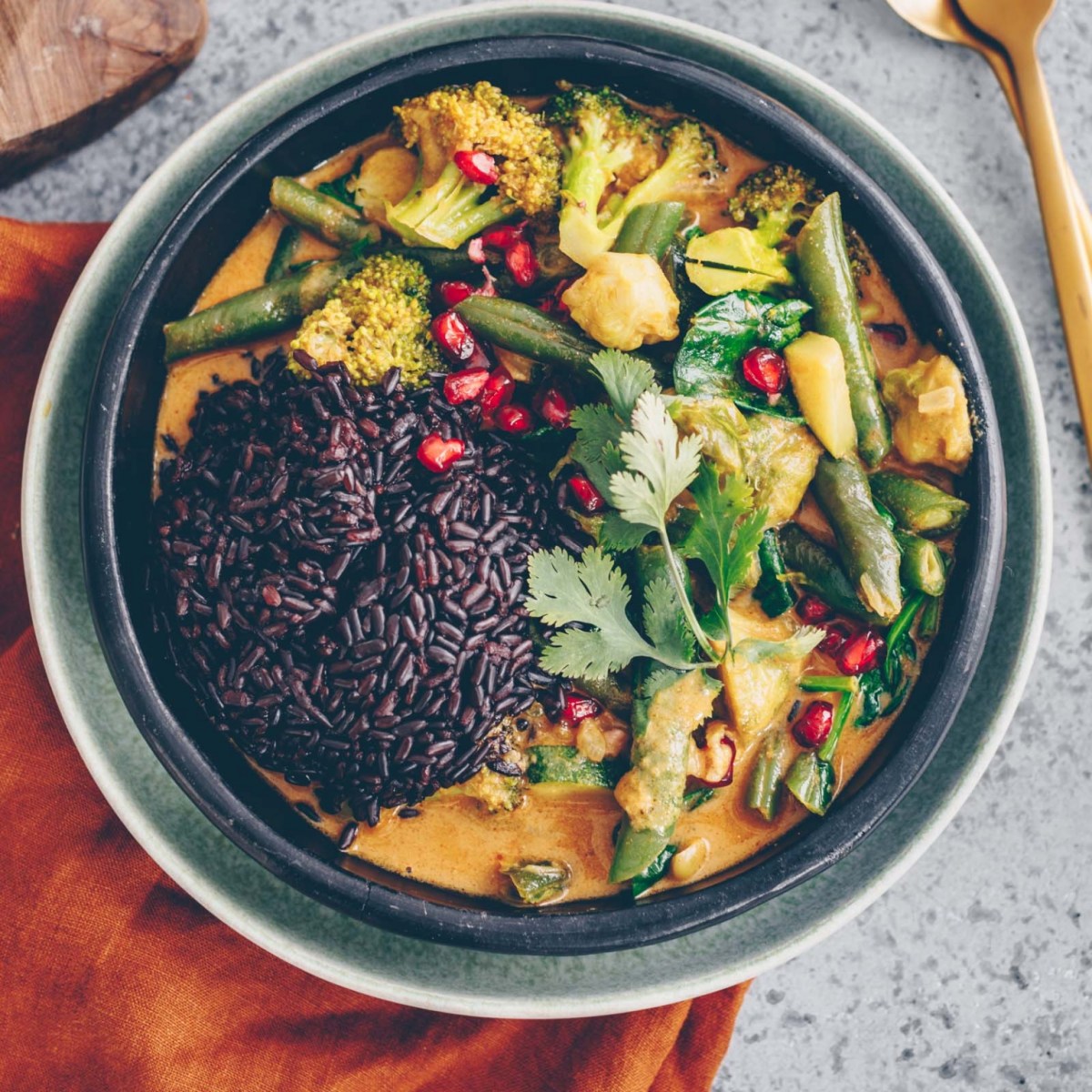Embark on a culinary journey exploring the vibrant world of healthy flexitarian curries! This guide unveils a collection of delicious and nutritious recipes, each carefully crafted to deliver a perfect harmony of protein and vegetables. Imagine the rich aromas of exotic spices mingling with tender protein and crisp vegetables, creating a symphony of flavors that tantalize the taste buds and nourish the body. Prepare to discover the secrets to creating flavorful, balanced meals that are both satisfying and good for you.
We’ll delve into diverse flexitarian curry options, from the creamy richness of lentil curries to the satisfying heartiness of chicken and vegetable creations. Learn to master essential cooking techniques, understand the importance of balanced nutrition, and unlock the art of crafting unique spice blends that will transform your culinary repertoire. This isn’t just about recipes; it’s about understanding the principles of healthy eating and creating exciting, flavorful meals that reflect your lifestyle.
Balancing Protein and Vegetables
A vibrant and healthy flexitarian curry relies on a harmonious balance between protein and vegetables. This balance isn’t just about taste; it’s crucial for maximizing nutritional value, ensuring satiety, and supporting overall well-being. The ideal ratio will vary depending on individual needs and preferences, but generally aiming for a roughly equal portion of protein and vegetables (by volume) is a good starting point. This approach ensures you receive a complete spectrum of essential amino acids from the protein source while reaping the numerous health benefits associated with a generous intake of diverse vegetables.
The interplay of protein and vegetables in a curry creates a symphony of flavors and textures. The protein provides a satisfying heartiness, while the vegetables contribute a burst of freshness, color, and vital nutrients. A well-crafted curry is a testament to this synergy, a culinary masterpiece that nourishes the body and delights the senses.
Vegetable Combinations Complementing Protein Sources
Choosing complementary vegetable combinations enhances both the nutritional profile and the sensory experience of your curry. For instance, the earthy sweetness of butternut squash and carrots beautifully complements the richness of lentils, while the vibrant green of spinach and kale pairs perfectly with the firm texture and subtle flavor of chickpeas. Similarly, the slightly spicy kick of bell peppers and onions adds a delightful counterpoint to the creamy texture and mild flavor of paneer (Indian cheese).
- Lentils & Root Vegetables: The combination of red lentils, butternut squash, carrots, and sweet potatoes provides a hearty and nutrient-rich base, offering a good source of fiber, vitamins A and C, and iron.
- Chickpeas & Leafy Greens: Chickpeas, spinach, and kale create a vibrant and healthy curry, rich in protein, iron, and vitamins K and A. The earthy chickpeas are balanced by the fresh, slightly bitter taste of the greens.
- Paneer & Bell Peppers: Paneer, a versatile Indian cheese, pairs wonderfully with colorful bell peppers (red, yellow, orange) and onions. This combination offers a good source of protein, vitamin C, and antioxidants.
Adapting Recipes for Dietary Needs
The beauty of flexitarian curries lies in their adaptability. Modifying recipes to accommodate various dietary needs is straightforward. For vegetarians, simply replace meat-based proteins with plant-based alternatives such as lentils, chickpeas, tofu, or paneer. Vegan curries can easily be achieved by omitting any dairy products (like paneer or coconut milk) and using plant-based alternatives like cashew cream or silken tofu. Gluten-free options are also easily created by using gluten-free soy sauce or tamari, and ensuring that any thickening agents used are gluten-free. Always check the labels of your ingredients to ensure they meet your specific dietary requirements.
To maintain a balanced and nutritious flexitarian curry, focus on incorporating a diverse range of vegetables and a suitable protein source. Remember to adjust the quantities based on individual preferences and dietary needs.
Spice Profiles and Flavor Combinations
Crafting flavorful and aromatic flexitarian curries hinges on the skillful blending of spices. The right spice combination can elevate a simple dish to a culinary masterpiece, transforming textures and unlocking complex flavor profiles that tantalize the palate. Understanding the nuances of different spice blends and their interactions with various proteins and vegetables is key to creating unique and satisfying curry experiences.
Five Distinct Spice Blends for Flexitarian Curries
The following five spice blends offer diverse flavor profiles, each ideally suited to specific protein and vegetable combinations. These blends showcase the versatility of spices in creating unique and balanced curries.
- Warm & Earthy Blend: This blend features turmeric, cumin, coriander, cinnamon, and cloves. Its warm, earthy notes pair beautifully with hearty root vegetables like sweet potatoes and butternut squash, alongside firm tofu or chickpeas for a satisfying vegetarian option. The spices’ inherent sweetness complements the natural sugars in the vegetables, creating a comforting and deeply flavorful curry.
- Bright & Zesty Blend: A vibrant mix of ginger, garlic, chili powder, garam masala, and lemon zest, this blend delivers a zesty kick. It’s perfect for lighter vegetables like broccoli, cauliflower, and green beans, complemented by firm paneer (Indian cheese) or shrimp for a light yet flavorful flexitarian option. The bright acidity cuts through the richness of the protein and vegetables.
- Spicy & Smoky Blend: For those who appreciate a fiery heat, this blend combines smoked paprika, cayenne pepper, chipotle powder, cumin, and oregano. The smoky notes add depth and complexity, pairing exceptionally well with hearty vegetables like eggplant and bell peppers. Lean chicken or firm seitan (wheat gluten) offer excellent protein sources that stand up to the intense flavors.
- Fragrant & Floral Blend: Aromatic and delicate, this blend features cardamom, star anise, fennel seeds, saffron, and a touch of rosewater. The floral notes lend an air of elegance, ideal for pairing with delicate vegetables like asparagus, peas, and spinach. A lighter protein like fish or firm tofu would complement the subtle yet rich flavors of this blend.
- Sweet & Savory Blend: This blend balances sweetness and savory notes with coconut flakes, curry powder, brown sugar, mustard seeds, and fenugreek. It creates a rich and creamy curry that pairs well with hearty vegetables like cauliflower and potatoes. Lentils or chicken thighs provide a substantial protein base that complements the sweetness and savory depth of the curry.
Curry Pastes vs. Curry Powders: A Flavor Comparison
Curry pastes and powders offer distinct flavor profiles and textural experiences. Pastes, often made with fresh ingredients, deliver a vibrant, intense flavor with a smoother, more cohesive texture. Powders, on the other hand, offer a more concentrated and complex flavor profile that can be adjusted to personal preference, but may lack the freshness of a paste.
Spice Combinations and Intended Flavor Outcomes
The following table illustrates various spice combinations and their intended flavor outcomes. These are guidelines; feel free to experiment and adjust to your taste preferences.
| Spice Combination | Primary Flavor Profile | Suggested Protein | Suggested Vegetables |
|---|---|---|---|
| Turmeric, Ginger, Garlic, Cumin | Warm, Earthy | Chickpeas | Sweet Potatoes, Spinach |
| Chili Powder, Coriander, Cumin, Garam Masala | Spicy, Aromatic | Chicken | Cauliflower, Bell Peppers |
| Cardamom, Cinnamon, Cloves, Nutmeg | Sweet, Aromatic | Lamb | Potatoes, Peas |
| Smoked Paprika, Cayenne Pepper, Cumin | Smoky, Spicy | Tofu | Eggplant, Broccoli |
Presentation and Serving Suggestions

Elevating a flexitarian curry from a simple meal to a culinary masterpiece hinges on thoughtful presentation and the strategic selection of accompaniments. The visual appeal of a dish significantly impacts the dining experience, stimulating appetite and enhancing overall satisfaction. Careful consideration of color, texture, and aroma will transform your curry into a truly memorable dish.
The following suggestions focus on enhancing the visual appeal of your flexitarian curry through strategic garnishing and pairing it with complementary accompaniments that enhance both texture and flavor profiles.
Visually Appealing Curry Presentations
Three distinct approaches can dramatically improve the visual appeal of your flexitarian curry. Each presentation employs a unique combination of colors, textures, and garnishes to create a captivating culinary experience.
First, consider a vibrant presentation where the curry is served in a shallow bowl, allowing the rich colors of the vegetables and spices to shine. A scattering of fresh cilantro, its bright green contrasting beautifully with the curry’s warm hues, adds a pop of freshness. Thinly sliced red chilies, adding a fiery red accent, provide a visual and subtle flavor contrast. Finally, a sprinkle of toasted coconut flakes offers a textural element and a subtle sweetness.
Second, a more elegant approach involves serving the curry in individual ramekins or small bowls. This presentation works particularly well for curries with a creamy texture. A dollop of plain yogurt or coconut cream, swirled elegantly on top, adds a creamy white contrast and a cool, tangy counterpoint to the curry’s warmth. A garnish of finely chopped toasted almonds provides a crunchy texture and a nutty aroma. A few threads of saffron, scattered sparingly, add a touch of luxurious golden color and a delicate, earthy flavor.
Third, a rustic presentation is achieved by serving the curry in a large, shallow platter, family-style. This presentation is ideal for gatherings and emphasizes sharing. A generous scattering of fresh pomegranate seeds, with their jewel-toned ruby red and juicy texture, adds a burst of sweetness and visual interest. A sprinkle of chopped fresh mint, its vibrant green contrasting beautifully with the pomegranate, offers a refreshing herbal note. Toasted pumpkin seeds, scattered amongst the curry, provide a textural contrast and a nutty flavor.
Accompanying Dishes for Enhanced Culinary Experience
The choice of accompaniment significantly impacts the overall dining experience. Each accompaniment adds a unique textural and flavor dimension, complementing the curry’s richness.
Serving your curry with fluffy basmati rice is a classic choice. The soft, slightly fragrant grains provide a neutral backdrop that allows the curry’s complex flavors to shine. The rice’s soft texture contrasts beautifully with the curry’s often more robust texture.
Naan bread, with its soft, slightly chewy texture and subtly sweet flavor, offers a delightful contrast to the curry’s intensity. The warm, slightly charred exterior of the naan provides a pleasing textural element, perfect for scooping up generous portions of the curry.
Quinoa, a nutritious grain with a slightly nutty flavor and a delicate texture, offers a lighter and healthier alternative to rice. Its slightly chewy texture complements the curry’s flavors, providing a pleasing textural contrast without overpowering the dish’s delicate balance.
From mastering the art of blending spices to perfecting the balance of protein and vegetables, this exploration of healthy flexitarian curries has unveiled a world of culinary possibilities. More than just a collection of recipes, this guide empowers you to create flavorful, nutritious meals tailored to your preferences and dietary needs. Remember, the key is experimentation – don’t be afraid to adjust spice levels, explore different vegetable combinations, and personalize your curries to reflect your unique tastes. Embrace the vibrant colors, tantalizing aromas, and satisfying flavors of these healthy and delicious curries, and embark on a culinary adventure that nourishes both body and soul.
Key Questions Answered
Can I make these curries ahead of time?
Yes, many flexitarian curries taste even better the next day! Store them in an airtight container in the refrigerator for up to 3 days.
What if I don’t have all the spices listed?
Feel free to substitute spices based on your preference and availability. The flavor profiles will vary slightly, but the overall dish will still be delicious. Experiment and find your favorite combinations!
Are these recipes suitable for freezing?
Yes, these curries freeze well. Allow them to cool completely before storing in freezer-safe containers for up to 2 months.
Can I adjust the spice level?
Absolutely! Start with less spice and add more to your taste. You can always add more, but you can’t take it away!


